Chicago Fire FC Stadium
| Capacity | 22 000 |
|---|---|
| Country | United States of America |
| City | Chicago |
| Clubs | Chicago Fire FC |
| Category | Design awaiting implementation |
| Cost | $650 M |
| Construction | 2026–2028 |
| Design | Gensler |
Advertisement
Chicago Fire FC Stadium – design description
What are the key features of the new stadium design for Chicago Fire FC?
The new Chicago Fire FC stadium is to be built near the city center, on an undeveloped plot of land formerly occupied by a railway yard, less than a mile west from the team's current home, Soldier Field.
Despite its attractive location, the site has not seen any investment for decades. In 2016, the development company Related Midwest became interested in the site and came up with an ambitious plan for a new neighborhood called The 78.
The developer wanted to create an unconventional project at the heart of the investment, one that would attract attention and increase the attractiveness of the location. After negotiations with numerous partners, Chicago Fire FC showed the most commitment and decided to locate its new stadium there.
Plans for the new venue were presented in June 2025. The construction cost, estimated at $650 million, will be covered in full by the club's owner, Joe Mansueto. Work is scheduled to begin in early 2026 and will take approximately two years.
The facility will take the form of a rectangular structure covered with a flat steel roof. The brick and glass façade is intended to reflect the traditions of the Chicago school of architecture and the city's industrial heritage. The stands, with a soccer-oriented layout, will have a capacity of 22,000 spectators.
Who are Chicago Fire FC?
The Chicago Fire soccer club was founded in 1997 and joined Major League Soccer (MLS), the most prestigious soccer competition in the US, in 1998. Already in its debut season, the team achieved great success, winning the league championship and the U.S. Open Cup, thus completing a double.
In the following years, the team remained among the top teams in the league, although it never managed to repeat the spectacular success of 1998. In 2003, Chicago Fire won the Supporters' Shield as the best team of the regular season. Over the years, the club has been represented by Hristo Stoichkov, Bastian Schweinsteiger, and Cuauhtémoc Blanco, among others.
With time, the team has lost its leading position and since 2010 has rarely advanced to the playoffs. Nevertheless, the club, operating in the third-largest metropolitan area in the US, is still seen as a team with tremendous potential – hence the nickname “sleeping giant”.
Who owns Chicago Fire FC?
In 2019, Joe Mansueto, a local billionaire and founder of Morningstar, a financial analysis company, became the new owner of the club. Mansueto had already owned 49% of the club since 2018, and a year later he took full control of the team.
Where has Chicago Fire FC played its matches so far?
From the beginning, the team played at Soldier Field, a large stadium located near downtown Chicago, which is also home to the NFL team, the Chicago Bears. In 2002–2003, when Soldier Field was undergoing reconstruction, the Fire's temporary home was Cardinal Stadium.
Between 2004 and 2006, the first stadium dedicated to Chicago Fire was built in the suburb of Bridgeview – Toyota Park (later SeatGeek Stadium). The team played there between 2006 and 2019, but when Joe Mansueto became the club's owner, the lease was terminated and the team returned to the monumental Soldier Field.
Why does Chicago Fire FC need a new stadium?
Although Soldier Field is a prestigious venue, its capacity (over 60,000 seats) far exceeds the needs of Chicago Fire. In addition, with plans to build a new stadium for the Chicago Bears, the future of Soldier Field is uncertain.
How did the plans to build a new stadium for Chicago Fire FC come about?
Where will the new Chicago Fire FC stadium be built?
The plans to build a new stadium for Chicago Fire FC are linked to a development project called The 78, which involves the redevelopment of a vacant lot located close to the city center.
The plot is located less than a mile west of Soldier Field, where the club currently plays its matches, at Roosevelt Road and South Clark Street, along the southern branch of the Chicago River.
The Chicago River used to run through the middle of this plot, but this changed between 1928 and 1930 when its bed was straightened and the old one was filled in with earth.
For years, the area was occupied by a wide railway yard – the tracks ran to Grand Central Station, located a short distance to the north. After the station closed in 1969, the tracks fell into disuse and were completely dismantled by the end of the 20th century.
How did The 78 development project come about?
The unused 62-acre plot near the center of a large metropolitan area was an attractive investment opportunity. Although there were many ideas for developing the site, including the construction of Amazon headquarters, an IKEA store, and river casinos, successive owners were unable to carry out any investment.
Since 2007, the land belonged to British-Iraqi billionaire Nadhmi Auchi (and his company General Mediterranean Holding). An unexpected problem faced by the businessman was the refusal to grant him a visa to enter the US.
In 2016, Related Midwest, a local branch of one of the largest real estate developers in the US – New York-based Related Companies – invested in the plot. The company entered into a partnership with the previous owner of the land, General Mediterranean Holding, with whom it formed Roosevelt/Clark Partners LLC.
Related Midwest's involvement brought a lot of momentum to the work on the development of the plot. Between 2016 and 2019, a series of public consultations and meetings with interested investors were held, attended by over 2,800 people.
In the meantime, formal procedures were also underway, including the approval of a change to the zoning plan and the creation of a Tax Increment Financing district. In April 2019, Related Midwest's plans received final approval from the City Council.
What is The 78 project?
Related Midwest's plans involve the construction of a new, multifunctional residential area, including offices, shops, restaurants, hotels, and other commercial spaces. In addition, squares, green areas, and a promenade along the river are to be created.
The name of the project refers to the 77 existing community areas in Chicago, suggesting that the investment will become the city's “78th neighborhood”.
How did Chicago Fire FC get involved in The 78 project?
Related Midwest, in addition to the “typical” development plans, also wanted to enrich the project with a key element that would attract attention and revitalize the space. One such venture was to be the Discovery Partners Institute, a branch of the University of Illinois, but ultimately the university withdrew from participation in The 78 project.
Another anchor was to be a sports facility located in the heart of the new neighborhood. Initially, there was talk of a baseball stadium for the Chicago White Sox (MLB) team. In early 2024, visualizations of the new arena were presented, and in the summer of 2024, the developer and the White Sox built a temporary baseball field on The 78 site.
The temporary showcase field was intended to encourage potential partners to participate in the project. However, local authorities were reluctant to participate in the costs (which were estimated at $2 billion, half of which the initiators intended to obtain from public funds).
In the fall of 2024, Related Midwest began to suggest that another sports team, Chicago Fire FC, was interested in building a stadium at this location. At the same time, the club's owner, Joe Mansueto, also began to speak about the construction of a new stadium, listing three sites as the most likely options: Lincoln Yards, Bronzeville Lakefront, and The 78.
Ultimately, Chicago Fire decided to build a stadium at The 78, and plans for the new facility were unveiled in June 2025. The club owner will cover the costs of the investment himself, which resolves the financing issues.
Although the soccer project has taken the lead, the White Sox continue to express interest in the investment. Theoretically, the construction of a second stadium or a shared, multi-purpose arena remains possible, but this is becoming less and less likely.
When were the plans for the new Chicago Fire FC stadium unveiled?
The plans for the new stadium were announced on June 3, 2025. On the day of the announcement, a preliminary sketch of the new venue was presented, and the club owner released a letter to fans and Chicago residents.
On June 16, 2025, the first visualizations of the stadium were presented, and shortly thereafter, additional details about the investment were also announced. The architectural concept was prepared by the renowned studio Gensler.
What will the new Chicago Fire FC stadium look like?
The design prepared by Gensler presents a symmetrical, rectangular structure with brick and glass facades and a flat steel roof. Inside, the facility will have a soccer-specific character and will seat 22,000 spectators. Its form is reminiscent in many ways of other recently opened MLS stadiums, such as Energizer Park, Lower.com Field, and GEODIS Park.
One of the key elements giving the building its individual character will be its facade. The brick walls with large rectangular windows refer to Chicago's industrial heritage, drawing inspiration from historic buildings and warehouses typical of the Chicago school of architecture, such as the Reid, Murdoch & Co. Building and the Chicago Building.
The stands of the new arena will be divided into two tiers, although this division will not be clear-cut: the main stand will have additional levels of boxes, and each of the stands behind the goals will have its own unique form – the one on the south side will accommodate a 2,000-seat safe-standing Supporters Section.
The facility will offer a variety of premium options, including skyboxes, VIP boxes, and exclusive clubs. In total, approximately 4,800 premium seats are planned.
The stands of the new Chicago Fire stadium will be steep and located close to the pitch, ensuring excellent visibility. From many seats in the stadium, fans will be able to see the famous Willis Tower (formerly Sears Tower), once the tallest building in the world – at least until it is overshadowed by new skyscrapers planned as part of The 78 project.
The auditorium will be completely covered by a steel roof, whose exposed truss structure is intended to refer to the nearby railway bridge over the Chicago River, fitting in with the industrial style of the entire project. The metal roof covering will enhance the acoustic experience, while the glazed end sections will allow more sunlight to enter inside.
The facility will be equipped with three large video screens, one of which will be located on the south stand, above the Supporters Section, and will measure 178 × 26 feet, making it one of the largest in MLS. The other two, measuring 60 × 24 feet, will be located on the north stand.
What are the objectives of creating the new Chicago Fire FC stadium?
The stadium will have a soccer-specific character and will primarily serve the Chicago Fire FC team. In addition to soccer matches, it will also be possible to organize other events there, such as concerts, festivals, rugby and American football games, trade fairs, corporate meetings, conferences, local initiatives, and many others.
The construction of the new facility is expected to contribute to the development of Chicago Fire FC – in line with the club's vision, it is to be a “world-class home for a world-class club”. Top-quality infrastructure will be available to players, and fans will benefit from excellent matchday conditions and an immersive sporting atmosphere.
The team's own modern facility is intended to strengthen the club's brand and identity, as well as anchor the team in the heart of Chicago for decades to come. Optimized capacity and the ability to manage the facility independently should result in higher revenues.
Between 2023 and 2025, the club also built a new training center (Endeavor Health Performance Center), which opened on March 3, 2025. The center is also located in the Roosevelt Road area, although further west, about 2 miles from where the new stadium is to be built.
What will be in the vicinity of the new Chicago Fire FC stadium?
The stadium will ultimately be surrounded by high-rise buildings, planned as part of The 78 project. An entrance plaza welcoming fans is planned in front of the north stand, and a large green square stretching between the stadium and the riverside promenade is to be built next to the west stand.
How will it be possible to get to the new Chicago Fire FC stadium?
The facility will be easily accessible thanks to an extensive public transportation network. There are bus stops nearby, and less than a mile away is Roosevelt station on the Chicago "L" rapid transit system, served by the Red, Orange, and Green Lines. Two suburban railway stations (Metra) are also relatively close by – LaSalle Street and Museum Campus/11th Street.
Additional parking lots and bicycle parking areas are also to be built around the stadium.
When will the new Chicago Fire FC stadium be built?
Construction of the stadium is scheduled to begin in early 2026. The facility is expected to be ready in about two years, in 2028, in time for the start of the new season. The cost of building the stadium is estimated at $650 million and will be covered by Chicago Fire FC owner Joe Mansueto, although the club and developer are hoping that the city will help with the necessary infrastructure around the facility.
The construction of the stadium is to be the first phase of the ambitious The 78 project, and the facility itself is to serve as a catalyst that will attract further investment. According to preliminary estimates, the implementation of the entire The 78 project may cost $8 billion.
Advertisement
Renderings
-
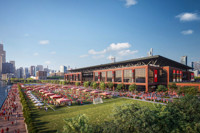
2025 © Chicago Fire FC 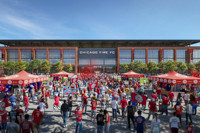
2025 © Chicago Fire FC 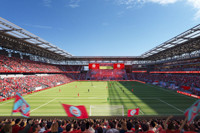
2025 © Chicago Fire FC 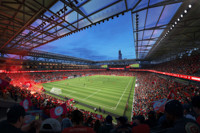
2025 © Chicago Fire FC 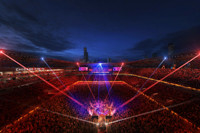
2025 © Chicago Fire FC 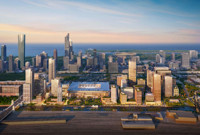
2025 © Chicago Fire FC 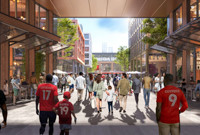
2025 © Chicago Fire FC 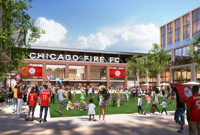
2025 © Chicago Fire FC 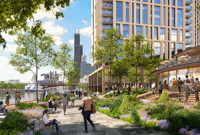
2025 © Chicago Fire FC 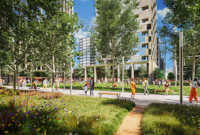
2025 © Chicago Fire FC
The 78:
Related news
2025
-
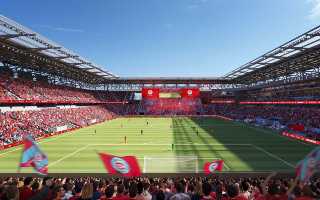
USA: Green light for Chicago’s first soccer-specific stadium
City council approves $650 million project, paving the way for club owner Joe Mansueto to build a privately funded 22,000-seat MLS stadium.
-
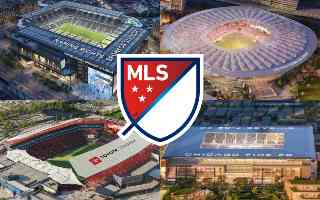
USA: Four stadiums of the future in MLS
Major League Soccer is investing heavily in stadium infrastructure, opening a new chapter in the league’s history. Across the United States, modern multifunctional venues are being built, aimed not only at improving fan comfort but also at becoming catalysts for local community development. From Miami to New York – MLS is building the stadiums of the future.
-
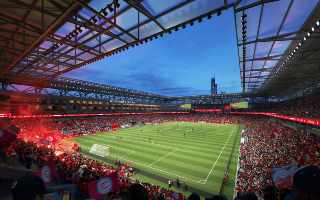
USA: First renderings of Chicago Fire FC stadium revealed
Chicago Fire FC has unveiled renderings and new details of a dedicated, $650 million soccer-specific stadium set to be built in downtown Chicago. Announced in early June, the stadium will be entirely privately financed by the club’s owner and chairman, Joe Mansueto.
-
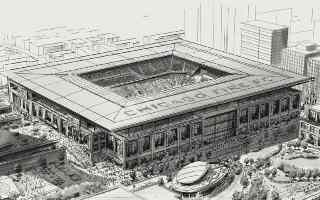
USA: Chicago Fire announces construction of new $650M stadium
Funded entirely by the owner, located on the river and built for football, rugby and concerts – this will be the new home of Chicago Fire. "Our city deserves a world-class club with a world-class home," the owner says.

 StadiumDB
StadiumDB